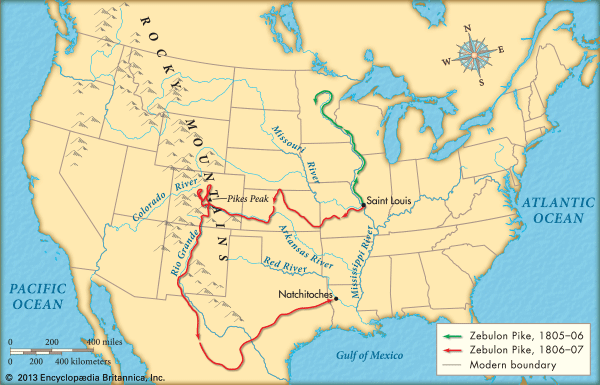Zebulon Pike: Explorer of the West
After the Louisiana Purchase gained the U.S. the Louisiana Territory, many people had a thirst for exploration of that new territory. Meriwether Lewis and William Clark are perhaps the most famous of those explorers, but another well-known explorer of the Louisiana Territory was Zebulon Pike, who lent his name to one of Colorado's iconic peaks. 
Pike was born on Jan. 5, 1779, in Lamberton, N.J. His father, also named Zebulon, was an officer in the Continental Army who, after the war, was stationed at outposts in what is now Illinois and Ohio but was then the new country's northwest frontier. Young Zebulon was 15 when he joined his father's regiment; he was named lieutenant in 1802. He was stationed at various places, one of which was Fort Bellefontaine, near St. Louis. Pike married Clarissa Brown in 1801. They had five children, only one of whom survived into adulthood. Their surviving daughter, also named Clarissa, eventually married John Harrison, son of President William Henry Harrison. 
In 1805, Louisiana Territory Gov. James Wilkinson, who had his headquarters in St. Louis, named Pike to lead a group of 20 men on a search for the source of the Mississippi River. They traveled from St. Louis to northern Minnesota, in boats and then in sleds because the river was frozen. Pike and his group made it to Leech Lake and were convinced that they had reached the source (which is actually Lake Itasca). They encountered several Native American tribes and kept or maintained good relations with them; in one instance, Pike met with Ojibwe chief and helped improve their relations with the neighboring Dakota tribes. Another, less well-known purpose of Pike's trip to this part of the country was to help regulate the fur trade. In what is now Minnesota, he met with fur traders there and set them straight on the need to follow the laws and regulations of the U.S.
Exploration Routes of Zebulon Pike

Pike's next expedition was along the Arkansas River, over the Rocky Mountains, and down into the Southwest, at the behest of the U.S. Army and with a contingent of those troops. Wilkinson charged Pike with escort freed Osage captives back to their homeland and to better relations with the Comanche, Kansa, and Osage tribes. He was the first known European to see Pike's Peak (which someone else named after him). Pike and his men found the source of the Arkansas River, achieving one of their goals. They set out for home. They were under strict orders not to enter Spanish territory but did so anyway. This resulted in their arrest and transport to Santa Fe and then to the provincial capital, Chihuahua. They were was later released, by Spanish troops who marched them to Fort Claiborne, in Louisiana. The Spanish had confiscated Pike's notes, most of them; he managed to smuggle some of them out without discovery. The Spanish returned the notes they seized many years later. (Some historians think that Pike deliberately crossed into Spanish territory, in order to be able to better assess Spain's readiness for war, should it come to that. Other historians cite the respect that the Spanish showed for Pike and his men in asserting that they weren't captured at all.) Pike kept notes of his journey, some of which were inaccurate. For example, he wrote that in his journey west he saw little land suitable for farming (when, in fact, the opposite is true), and his observations had an indirect effect of discouraging settlement in the area for a time. However, he did provide some reasonable intelligence on the military readiness of the Spanish, which U.S. officials found useful. He published an account of his travels in 1810: The expeditions of Zebulon Montgomery Pike to Headwaters of the Mississippi River, through Louisiana Territory, and in New Spain, during the Years 1805-6-7. It proved so popular that it was translated into three European languages: Dutch, French, and German. 
Pike achieved the rank of brigadier general and fought in the War of 1812. He was promoted to captain during his second expedition. He fought with Harrison at the famous Battle of Tippecanoe and then promoted to colonel. He also served as deputy quartermaster-general and inspector-general. He didn't make it through the war. He led his men to victory in the Battle of York, in Canada, on Jan. 1, 1813. He led an assault that drove the British out of their fortified location; the escaping British rigged an explosion, which killed 52 Americans and injured 180 others. Among those injured was Pike, who did not survive. He died on April 27, 1813. He was 34. 
Pike himself didn't stand atop the peak named for him. In fact, he and his men attempted it but had to turn back because of bad weather. They went on and did not return. Fourteen years after Pike "discovered" it, a man named James climbed to the peak; this resulted in its being called James Peak. The discovery of gold in Colorado in the 1850s resulted in a gold rush, during which Pike's name was affixed to the peak. One of the well-known slogans of settlers heading west was "Pike's Peak or Bust." His name inspired new generations of explorers. He is also remembered as the inspiration for the names of many landforms, counties, buildings, national parks, forts, and ships. |
|
Social Studies for Kids
copyright 2002–2025
David White




